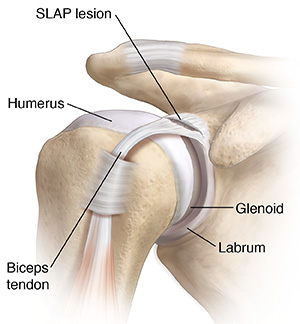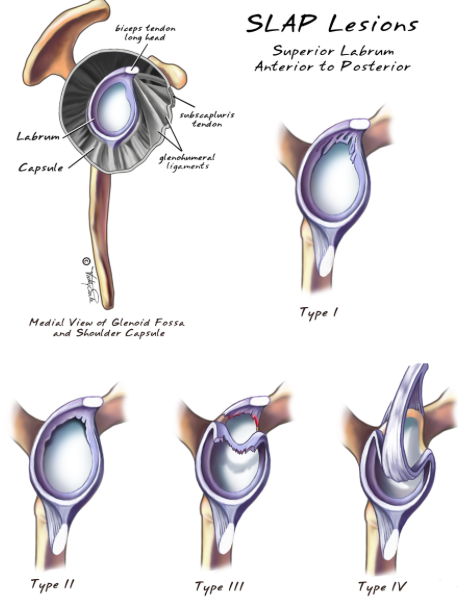What is it?
It is a lesion of the articular fibrocartilage of the shoulder, called the labrum or glenoid rim. The name is an acronym for the initials Superior Labrum from Previous to Posterior. There are different types of SLAP, depending on their severity.

Types of SLAP according to Snyder (1990).

Video:
https://www.youtube.com/watch?v=WOWJacen9A0
Causes
The most frequent cause of injury in climbing is when one hangs on one arm (for example, when one foot goes away). At that time the patient reports suffering a sharp pain inside the shoulder that subsequently remains sore. Another very frequent mechanism is the fall with the arm in hyperextension, by a slip walking on the approach, by a skid when stepping on ice, or by a fall while skiing.
This injury in its beginning was described among pitchers of baseball, being very frequent in these. Possibly this gesture may be related to the movements of hyperextension and internal rotation (shoulder step) that are often made in climbing, or with the movement of punching the ice axe.
Incidence
Recent studies suggest that shoulder injuries have a very high incidence. Recent studies report that it is the second most frequently injured anatomical region, and among shoulder injuries, SLAP is the most common (Schöffl et al, 2015). Consequently, the community of climbers must be aware that it is a very important injury to consider.
Diagnosis
The diagnosis is based on the clinical history, the patient reports a diffuse pain located mainly on the anterior side of the shoulder, inability to sleep on that shoulder, instability when performing movements above 90º, accompanied by pain, joint clicks and loss of strength. Many times said pathology is accompanied by tendinopathies of rotator cuff tendons.
The generation of the lesion movement reproduces pain, which may be a physical test that can suggest this diagnosis (arm elevation combined with external rotation). Asking the patient to throw an object can trigger pain. Given these suspicions, it is advisable to perform an arthroresonance or contrast resonance to evaluate the state of the glenoid labrum, or an arthroscopy for an in situ evaluation.
Treatment
There are different grades of SLAP, in the initial stages (SLAP type I and II) conservative treatment is recommended, based on the re-centering of the humeral head through exercises with gums, together with the reduction of the stress of said tissue (relative rest, avoiding the mechanism of injury, it is necessary to climb fifths). In higher grades surgery and subsequent physiotherapy treatment is indicated, with an estimated recovery time of between 3 and 6 months.
Prevention
There are several prevention exercises for this type of injury. The ones shown below are made by means of rubber bands, and they are considered suitable to be carried out before each climbing and / or training session. In this way, the exercises are used both to complete the warm-up and to strengthen the anatomical structures of the shoulder and thus reduce the likelihood of future injuries.
Recommended exercises:
Bibliography:

